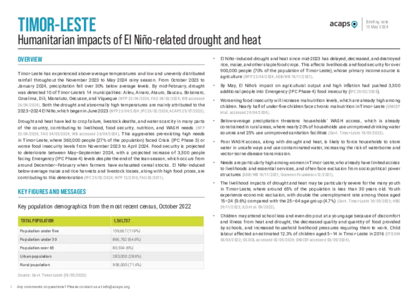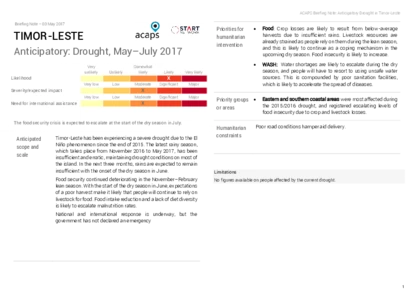Latest updates on country situation
27 February 2024
About 360,000 people (27% of the population) could be facing Crisis (IPC Phase 3) or worse food insecurity levels from November 2023 to April 2024 – 100,000 more than the anticipated figure for May—September 2023. The estimated number of people facing Emergency (IPC Phase 4) levels also increased from 7,000 to 18,600 in the same period. The prices of rice and maize, the two main staple foods, increased in 2023. Timor-Leste heavily depends on imported rice, the price of which increased by 30% in December 2023 compared to December 2022. The price of maize in the country rose by 66% during the same period, and its production is expected to decrease in 2024 because of El Niño and fall armyworm infestations. The food insecurity situation will likely significantly affect the country’s children. Half of the children under five face chronic malnutrition, and nearly 40% are underweight. (WFP 19/02/2024, UNICEF accessed 27/02/2024)
Analysis products
on
Timor Leste
13 May 2024
Timor Leste: Humanitarian impacts of El Niño-related drought and heat
DOCUMENT / PDF / 626 KB
From October 2023 to January 2024, precipitation fell over 30% below average levels. By mid-February, drought was detected 10 of Timor-Leste’s 14 municipalities: Aileu, Ainaro, Atauro, Baucau, Bobonaro, Covalima, Dili, Manatuto, Oecusse, and Viqueque.
03 May 2017
Southern Africa: Cyclone Season
DOCUMENT / PDF / 256 KB
Timor-Leste has been experiencing a severe drought due to the El Niño phenomenon since the end of 2015. The latest rainy season, which takes place from November 2016 to May 2017, has been insufficient and erratic, maintaining drought conditions on most of the island. In the next three months, rains are expected to remain insufficient with the onset of the dry season in June.



